Better Onboarding: How to Set Volunteers Up for Success
Discover five practical ways to improve volunteer onboarding—plus a free worksheet to help you communicate clearly and support new volunteers from day one.

Struggling to keep volunteers engaged, supported, and coming back? The problem might be your onboarding process. A well-structured, thoughtful approach to volunteer training doesn’t just boost retention—it strengthens your entire mission.
In this guide, I’ll walk you through what goes wrong in typical nonprofit onboarding (and how to fix it), then share five best practices for building a volunteer experience that’s welcoming, clear, and confidence-building from day one.
Why Volunteer Onboarding Falls Flat (and What It Costs You)
For many small and mid-sized nonprofits, onboarding is an afterthought. With stretched teams and urgent demands, it’s tempting to jump straight into the work. Too often, organizations lean heavily on informal shadowing—assuming new volunteers will “pick things up” by watching someone else. But just because someone knows how to do a task doesn’t mean they know how to teach it. That shortcut often leads to:
- Confused volunteers unsure of what to do or whom to ask
- High turnover from unmet expectations or disconnection
- Staff burnout from repeating the same instructions over and over
Poor onboarding isn’t just inefficient—it’s demoralizing. And it quietly drains your organization’s momentum.
The good news? A few strategic tweaks can transform the experience—for your volunteers and your team.
Volunteers Aren’t Staff: Why Their Onboarding Needs a Different Approach
You can’t just repurpose your staff orientation. Volunteers bring different motivations, schedules, and learning preferences. That means they:
- Need flexibility, especially if they’re balancing work, family, or school
- Value clarity and connection more than just rules and routines
- Are unpaid—so their motivation comes from feeling useful, welcomed, and appreciated
It’s easy to focus on rules and requirements—especially when you’re juggling risk management or safety concerns. But volunteers aren’t motivated by compliance alone. They show up—and keep showing up—when they feel confident in their role and a genuine sense of belonging. That’s what lays the groundwork for deeper involvement.
The 5 Core Practices for Successful Volunteer Onboarding
1. Define the Role Upfront: Set Clear Expectations Early
Give each volunteer a simple, written description of:
- What they’ll do
- When and where they'll do it
- Who to contact with questions
Example: If you’re running a food pantry, clarify whether they’ll be stocking shelves or interacting with clients. Don’t let assumptions drive mismatched experiences.
Why it matters: Volunteers who understand their role from the beginning are more confident, make fewer mistakes, and are more likely to stick around.
Pro tip: A short checklist or one-page welcome guide can help reinforce expectations without overwhelming anyone.
2. Make Orientation Engaging, Not Just Informative
Your orientation sets the tone. Whether it’s live or self-paced, aim to include:
- Your mission and the “why” behind the work
- Safety and logistical basics
- A moment for connection (even 5-minute introductions help!)
Example: In a tutoring program, you might say: “The hour you spend here can help someone apply for a better job or read to their child for the first time.” This helps connect their service to real-world outcomes.
Why it matters: Volunteers aren’t just looking for instructions—they want to feel part of something meaningful. A warm, inspiring orientation increases emotional investment and helps them feel a sense of community.
3. Offer Role-Specific Training That Builds Confidence

Once volunteers know the basics, they need to feel equipped to do the actual work—especially if they’ve never done it before. Depending on the role, try:
- Hands-on practice alongside a supportive team member
- Walkthrough videos (especially helpful for museum docents or library volunteers)
- Role-play scenarios or cheat sheets
- Simple, reusable tutorials volunteers can revisit anytime
Example: After some basic training, a museum might have a new docent lead a few tours with a seasoned partner before stepping into the role on their own.
Why it matters: Volunteers who feel prepared and confident in their tasks are less likely to become frustrated or disengaged—and more likely to come back.
Pro tip: Use a platform like Niche Academy to house all your volunteer training in one place—complete with videos, checklists, and quizzes. It’s an easy way to ensure every volunteer gets the same clear, engaging onboarding experience.
4. Use Consistent Communication to Build Connection
To support strong communication from the start:
- Pick one go-to channel (email, Slack, WhatsApp) and tell volunteers: “This is where updates live.” Then stick to it.
- Ask how each volunteer prefers to be contacted—some may prefer text, others email or phone.
- Always follow up after the first shift. A simple “How did it go?” message shows you care.
Example: A food bank might send a quick text the day before a shift to confirm availability, then follow up afterward to say thanks and ask for feedback.
Why it matters: When communication feels reliable and personal, volunteers feel like part of the team—not an afterthought.
5. Show Recognition and Foster Belonging
Don’t wait until Volunteer Appreciation Week. Recognition can be simple, personal, and done regularly:
- Say thank you—early and often
- Mention volunteers in newsletters
- Share stories of impact with their name attached
- Invite them to informal gatherings, like coffee chats or monthly meetups
Example: A community arts center might highlight a different volunteer each month in its newsletter or post thank-you notes on a shared bulletin board. These small gestures can go a long way in making people feel seen.
Why it matters: Volunteers who feel appreciated and included are more likely to stay involved—and become powerful advocates for your mission in the community.
What Happens When You Get Volunteer Onboarding Right?
- Volunteers show up prepared and motivated
- Staff spend less time retraining and troubleshooting
- Retention improves—and so does morale
And perhaps most importantly, your organization becomes known as a place where people want to contribute.
Successful onboarding ensures people feel capable, supported, and connected from the start.
Onboarding Is Mission Work
When you invest in onboarding, you’re not just checking a box—you’re building the relationships that fuel your mission.
Quick Wins
And it doesn’t take a full overhaul to make a difference. Start small:
- Record a quick welcome video
- Draft a basic FAQ for new volunteers
- Create a go-to spot where new volunteers can access training materials, FAQs, and guidance at their own pace—Niche Academy makes this easy
- Follow up after a volunteer’s first shift to thank them or offer support
- Add a welcome message and clear role description to your next volunteer email
- Ask volunteers for feedback after their first few shifts—and use it to improve their experience
Even small touches like these help people feel supported—and more likely to come back.
📥 Download our Free Volunteer Welcome Guide Worksheet
Use it to create a simple, go-to resource that answers common volunteer questions and helps new team members feel informed, confident, and ready to get started.

.png)
.png)
.png)

.png)
.png)
.png)

.png)
.png)

.png)